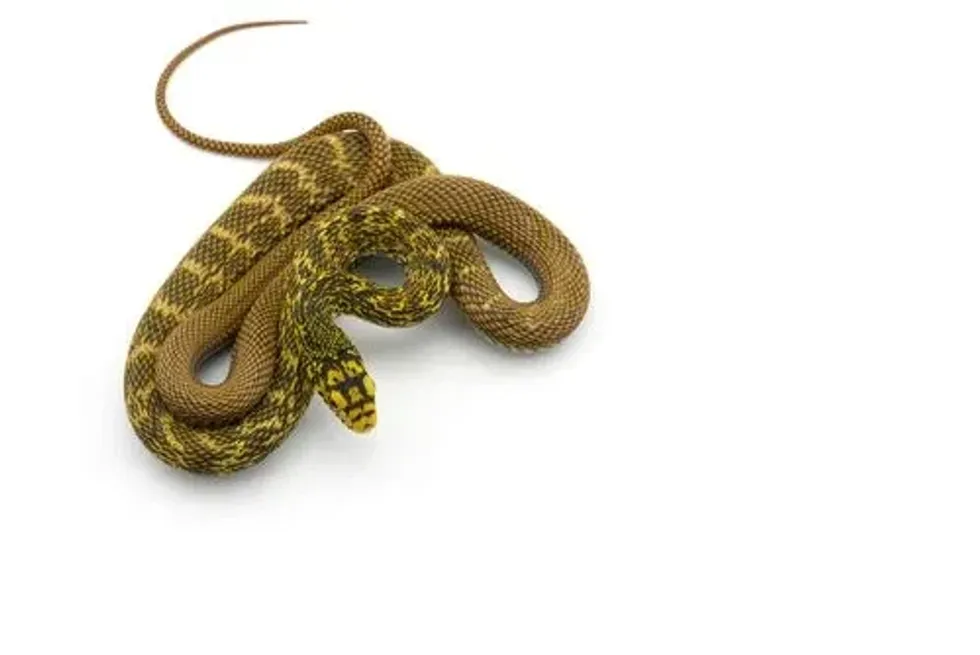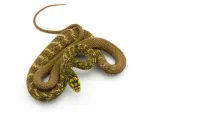The King Rat Snake, Elaphe carinata, is also known by its common name, Stinking Goddess. This species of snakes along with Kingsnakes, Vine snakes, and Indigo snakes are part of the sub-family Colubrinae, part of the family of Colubridae.
The King rat snake is quite large and has a strong-looking body. There are three subspecies of the same genus Elaphe.
The names of the three subspecies are - Elaphe carinata, Elaphe yonaguniensis, and Elaphe dequenensis.
The subspecies we are studying here is Elaphe carinata, which is also known as the Taiwan Stink snake. The Elaphe dequenensis which is found mostly in the Yunnan province in China is similar to the Elaphe carinata and is just a small local form of it.
The name, King Ratsnake is given to the Elaphe carinata because of their habit of eating other snakes, even the venomous ones like cobra and viper. Rat snakes mostly used as reptile pets all over the world are not venomous and are easily trained.
The distribution of these beautiful animals is worldwide, some of them other than the King Ratsnake, are the Gray rat snake and the Black rat snake.
Both these species of snake are found in North America. Read all the snake facts right here on the Kidadl website.
King Rat Snake Interesting Facts
What type of animal is a King Rat Snake?
The King Ratsnake is a type of non-venomous snake.
What class of animal does a King Rat Snake belong to?
The Elaphe carinata falls under the class of Reptilia in the kingdom of animals.
How many King Rat Snakes are there in the world?
The population of the Elaphe carinata is unknown at the moment, but there is no immediate danger to this community of snakes in the world.
Where does a King Rat Snake live?
These bottom-dwelling species of King Ratsnake are found exclusively in China, North Vietnam, Taiwan, and Japan.
What is a King Rat Snake's habitat?
The King Ratsnake is a terrestrial species and is found mostly in open forest areas, bamboo thickets, humid areas, fields, and meadows. They are also sometimes found in urban areas, near houses.
In captivity, it is fairly easy to be taken care of. They need plenty of space to move around, and the breeds should be kept separately as the King Ratsnake has shown cannibalism in the past.
Even the young are fairly large after hatching and need a big area in the cage.
They love to dig through the soil, so a thick layer of ground cover is required. Climbing branches, hollow logs, and reptile caves are some other ornaments that can be added to make the King Rat snake pet feel like living in its natural habitat.
Who do King Rat Snakes live with?
They often are seen in solidity. They are known to prey on their kind, so they are comfortable living on their lonesome.
How long does a King Rat Snake live?
The Elaphe carinata is known to live 25-30 years in captivity. However, in the wild, the average lifespan of the snakes is around 10-15 years.
How do they reproduce?
The species is oviparous and lays one clutch of eggs in a year. There have been rare cares of two clutches in a year if the right conditions are met. Mating for the adult king rat snake starts in the spring season and 6-12 eggs are laid in mid-summer months. The incubation period lasts for 40-60 days on average.
What is their conservation status?
Rat Snakes are pretty commonly found reptiles in the countries of China, Taiwan, and Japan and are not a protected species. They are even the most commonly seen snakes in restaurants in those countries.
Consequently, their status is Least Concern. However, the skin trade is also common in China for these animals. The King Ratsnake is also a part of exotic pet trades all over these places.
King Rat Snake Fun Facts
What do King Rat Snakes look like?
The King rat snake is known to have keeled scales. The adults are black with yellow coloration on those keeled scales. Young ones are fairly different in appearance from the adult animals with a brown/gray body with a fine dark pattern.
The pupils of the snakes are in the shape of a teardrop. Some of them show very dark-colored bodies and a few others show striking shades of yellow. The range of colors on their bodies is astonishing.
The Albino King Rat snake is a beautiful breed of kingsnakes and has unique colorations on its body. The distribution of these snakes in the family of animals is found all over the world and is heavily domesticated.

*Please note that this is an image of a black rat snake, not a king snake specifically. If you have a royalty-free image of a king rat snake, please let us know at hello@kidadl.com
How cute are they?
These are beautiful species of animals and are often seen as pets in many homes.
How do they communicate?
Snakes are known to communicate through pheromones and body movements. They might also communicate through sounds.
How big is a King Rat Snake?
The King Rat snake's length ranges from 4-6 ft. All rat snakes are longer than most other snakes.
How fast can a King Rat Snake move?
The King Ratsnake is a fast and swift-moving snake, gentle and always ready to attack and bite.
How much does a King Rat Snake weigh?
The weight is unknown at the moment.
What are the male and female names of the species?
The male and female sexes of the King Ratsnake are not given different names. Instead, they are known by their common name and scientific name.
What would you call a baby King Rat Snake?
A baby King Rat snake is known as a hatchling.
What do they eat?
The diet of the Elaphe carinata ranges from a variety of rodents like rats and mice, small mammals, amphibians, birds, fish, and other snakes (even the venomous ones). Since they feed on other snakes, they have the word 'King' attached to their name.
The King Ratsnake or Elaphe carinata is a large and heavy snake and is usually terrestrial.
They have also shown cannibalism to the effect that they eat their kind when given a chance. The Chinese King rat snake is a breed of active predatory snake that eats everything from rodents to birds, along with other snakes.
Are they poisonous?
This species is non-venomous. When they are threatened, these snakes rattle their tails to fool other animals into thinking that they are poisonous. The name is Stinking Goddess is given to the Elaphe carinata because the snake releases a strong bad odor through its highly developed post-anal glands. This smell is released when the snake is picked up.
Would they make a good pet?
The King Ratsnake is kept as a pet all over the world. They are very hardy and make for a good pet for most.
The King Rat snake defense mechanism is the only thing that is a little annoying, as they spray a foul-odored smell when picked up by the owner. In general, it doesn't take much effort for the King Rat snake to care in the cage.
Did you know...
They are known to bite only if threatened but are non-poisonous.
They eat all chicken if given a chance.
How does a King Rat Snake kill its prey?
These non-venomous snakes kill their prey by strangulation and suffocating them.
What is the difference between a King Snake and a Rat Snake?
Rat snakes have irregularly shaped blotches down the length of the body. The Kingsnake has yellow stripes down its back. Also, King snakes feed on other snakes, hence the name.
Here at Kidadl, we have carefully created lots of interesting family-friendly animal facts for everyone to discover! Learn more about some other reptiles including the eastern rat snake and yellow rat snake.
You can even occupy yourself at home by drawing one on our King rat snake coloring pages.










